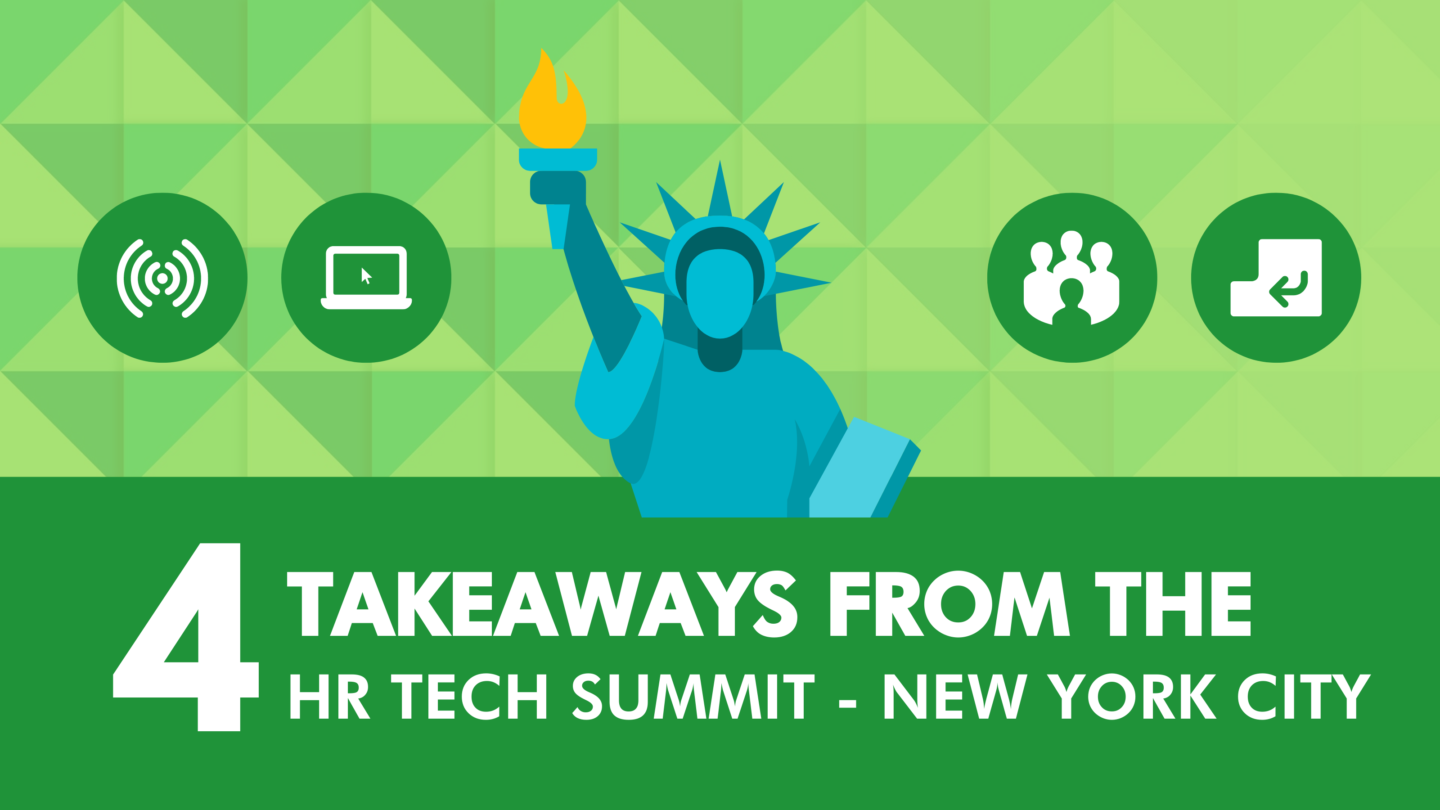
4 Takeaways from the HR Tech Summit - New York City
Introduction
SpriggHR’s Jilaine Parkes and Tony Kerekes were among many HR and Tech professionals to attend the HR Tech Summit in New York City on November 6th, 2019.
Jilaine gave a talk about how to align & cascade key objectives in a business and also participated in a panel discussion with HR leaders from MetLife and Microsoft about how to best utilize HR data to drive performance.
A CHRO, in her second high-growth tech company, noted, in the last 5 years there has been a large shift from governance and compliance to driving the business (with talent and talent solutions).
1. People Analytics
Attendees to the conference indicated a significant interest, and desire for, increased use of people analytics. Most agree that the benefits of having hard data to support people decisions, identify trends and validate investments in talent are enormous.
The larger organizations are leveraging advanced analytics with teams that support the need for reports, analysis, and data interpretation. Other HR leaders have taken on this challenge and are now looking to learn relevant analytical skills themselves in order to keep up in this ever-advancing field.
Microsoft indicated they are hiring into HR from some MBA programs that teach analytics and HR analytics, over students with a masters in HR or IR. A tool such as Twine Labs can produce insights, but you need to know the questions to ask and how to weave results into a story and recommendations.
There’s no denying that we are seeing an evolution in the desired skillsets of an HR professional; perhaps analytical skills will become an expectation in the future.
Speaking of the future...
2. The Future of HR Competencies
With all of the talk about how new technologies and methods of analysis are changing the landscape of HR, the obvious question on many attendees’ minds was:
How will the role of future HR professionals change?
Although the immense potential of HR data analytics has yet to be realized in most business settings, analytical capabilities are still highly desirable skills that may serve to differentiate HR professionals in the future.
In the past, data analysis may not have played as central a role in an HR professional’s job description, but this may change going forward. As technology advances and more and more innovative tools become available to us, an ability to effectively utilize these tools increases. Future HR professionals will be equipped with more data than ever before, and it is important to know how to leverage such data in order to optimize strategic decision making. HR can use data from their companies enterprise systems, financial systems and HR systems to knit together a business case for HR decisions.
For example, looking at actual business unit results, candidate sourcing and performance management data over time, a better picture can be generated on the best hires, sources, internal training, results, etc. If you have a significant percentage of new hires through employee referrals, you can compare the performance and tenure over two to three years to other hires and glean insights.
It seems quite apparent that future HR professionals will need to be adept in the technology space. Understanding how to leverage technology to create workforce engagement, reducing paper and cycle time on HR processes will be critical when all of us are faced with lower budgets and resources.
3. Managing & Implementing HR Technology
While there’s a nearly unanimous agreement that HR technology and analytics offer a range of benefits, companies are slow to adopt these practices? Many of the attendees spoke of the difficulty associated with the integration of various tools to work together and the adoption across the organization. In some cases, self-service and mobile tools have helped propel adoption.
- The complexity, resources, and time required to implement new HR technology was one area that was on most people’s minds. As a panelist noted, technology itself creates stress as there are so many possibilities and functionalities that like a kid in a candy store, its hard to make a choice and to pare back to true needs, making implementation more challenging.
- There is always an organizational reluctance to switch from a current, familiar application, even if a superior, more intuitive, lower-cost option becomes available. A large company indicated that having new fields and definitions, also makes historic data analytics more challenging.
- AI can be used to source candidates by pointing to an optimal candidate on LinkedIn and having your tool produce a list of best matches on LinkedIn. Then imagine being able to do a comparative analysis two years later using LinkedIn with your number 2 or 3 candidates and the one you hired.
Although it is true that many barriers exist, the same can be said about any game-changing advancement, be it technological or otherwise. The fact of the matter is that benefits outweigh the costs of overcoming these barriers, and that is why we are seeing companies persevere.
4. Leveraging Social Networks for Today’s Workforce
With the technology currently available to us, it is not uncommon for an individual to be able to complete all aspects of their position remotely. For this reason, recognition of a permanent, distributed workforce is a new reality for many companies today. With this change in structure to the conventional workplace comes the need to address the associated decrease in social interactions among employees. Conference attendees had a variety of thoughts and ideas:
- What tools, processes, and norms will you create to knit people together so that people are more likely to stay? Leveraging tools like Slack beyond work can help engage employees with each other.
- A best practice from one organization – go beyond the usual work topics, create broad communities so that employees can engage and support each other beyond work. Pet channel? Food channel? Things to do this weekend channel?
- A tip from one HR leader – connect new employees during onboarding so they can grow their network outside of their immediate team. Remote workforces need to build relationships when they aren’t meeting each other face-to-face.
- A global finance organization noted the technology can fostering collaboration and the right behaviours, they switched to Zoom (with pushback) and after a year asked employees for feedback. Most indicated they collaborate better and never use their landlines and would give them up.
Issues such as a decreased sense of community that are associated with distributed workforces are important to address. Face-to-face social networks have existed for a long time, and have been shown to drive retention and engagement. Implementing internal social networks through technology is a potential solution to engaging a distributed or hotelling workforce.
Final Thoughts
We hope that our summary has provided you with some insight and given you some things to think about. Key Media organized a great line-up of interesting speakers.
Ready to learn more about how Sprigg addresses these areas?
We would love to introduce you to Sprigg. Hit the “Request a Demo” button and we'll customize a demo just for you, led by one of our senior HR professionals. We look forward to connecting!



